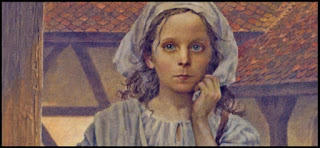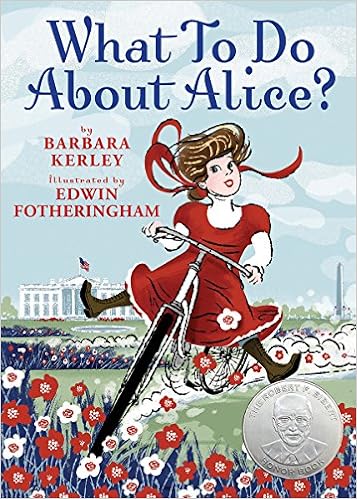
BIBLIOGRAPHY
Schmidt, Gary D. 2007. THE WEDNESDAY WARS. New York, NY: Clarion Books. ISBN 0618724834
PLOT
SUMMARY
Holling Hoodhood, a seventh grader at Camillo Junior High
School has to face a teacher who is out to get him, parents who ignore him, a
bully, a girl-he-really-likes, and being Protestant. Who can’t relate? As Holling struggles to be a good son and
succeed in school, the effects of the Vietnam War take hold of his community. Holling’s sister is a “flower child” and
wants to support Bobby Kennedy in his run for office, but then Kennedy is killed. The school lunch lady’s husband is killed in
action and Holling is standing by to watch the “great sadness” pour out of
her. His teacher’s son goes missing in
the Vietnamese jungle and there is no news.
When he is miraculously found alive months later, he watches the “great
joy” explode out of his teacher. Throughout
the course of the novel, Holling participates in a few shenanigans, joins the
cross country team, takes the girl-he-really-likes out on a date, and learns to
love Shakespeare. In the end, he learns
that he really does love his sister and that people are not always what they
seem.
CRITICAL
ANALYSIS
This novel starts out innocently and humorously. A typical seventh grade kid with a ridiculous
name becomes our protagonist. The reader
can see themselves in his shoes with all the same problems (dating, school,
parental expectations, bullies, teachers who hate us, and wanting to find out
who we are). Once we are hooked into our
characters and following the often hilarious plot, the novel becomes a gripping
account of people trying to understand the Vietnam War.
This novel is set in 1967 in a Long Island suburb. Schmidt does not come out and tell us where
we are or what is happening, but he weaves the details of the setting into
every aspect of the story. The
construction of the buildings (with asbestos tiles) and the teaching style
(diagraming sentences and reading LOTS and LOTS of Shakespeare) are an integral
part of the action. Walter Cronkite
delivers the news about what is happening in Vietnam every night, and Holling
wants to drive his dad’s brand new 1968 Ford Mustang.
This novel is the first thing I have ever read about the
Vietnam War that was meant to be entertaining.
The confusion the American people faced and the sorrow when men came
home in coffins becomes real for the reader.
Schmidt does an
amazing job of hooking his reader with humor and junior high antics and then
turning this coming of age novel into a tremendous source of understanding
about a terrible time in our history. How
do I share with you all the events and lessons and changes that Holling faces
in this novel? I cannot even begin to cover
them all here. You are going to have to
go read this book for yourself. Go now.
AWARDS
AND REVIEWS
·
Newbery Honor Book
·
ALA Notable Children’s Book
·
Texas Lonestar Reading List 2008
·
STARRED
REVIEW from Publishers Weekly: “…first-person
narration perfectly captures Holling's progression from an angst-filled yet
innocent boy, to a wiser, self-aware young man. His reading is touching, funny
and insightful; he manages to bring the listener back to a time—real or
nostalgically re-imagined, at least—when the crack of a bat against a ball in
Yankee Stadium or sharing a Coke with a girl at the Woolworth's counter was all
any boy could want. This is a lovely, heartfelt novel, read with as much care as
the author used to create it.”
·
STARRED
REVIEW from Booklist: “…Schmidt, whose Lizzie Bright and the Buckminster Boy
(2005) was named both a Printz and a Newbery Honor Book, makes the implausible
believable and the everyday momentous. Seamlessly, he knits together the
story's themes: the cultural uproar of the '60s, the internal uproar of early
adolescence, and the timeless wisdom of Shakespeare's words. Holling's
unwavering, distinctive voice offers a gentle, hopeful, moving story of a boy
who, with the right help, learns to stretch beyond the limitations of his
family, his violent times, and his fear, as he leaps into his future with his
eyes and his heart wide open.”
CONNECTIONS
·
Read and analyze
a poem or a play by Shakespeare (one that is mentioned in this book would be
ideal).
·
Cross-curricular
history lesson about the Vietnam War, Bobby Kennedy, Martin Luther King Jr.,
the Civil Rights Movement, or the “Hippie” movement.
·
Cross-curricular
lesson with an Outdoor Education or PE class to play baseball and discuss
batting averages.
·
Students can
write a personal narrative about a person that has made a strong impression in
their lives.
·
Students can
write a letter to somebody who has helped them through a hard time or always
been there for them.
·
A lesson on our
current military and how we can respect our soldiers.
·
Read other books
by Schmidt: LIZZIE BRIGHT AND THE
BUCKMINSTER BOY or STRAW INTO GOLD.
 |
| Oh the rats! You will have to read the book to learn about the HILARIOUS situation with the rats! |
Images taken from: www.google.com















